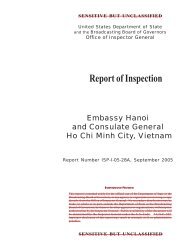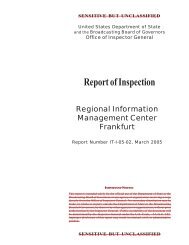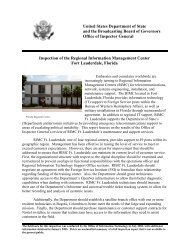Evaluation of Department of State Information Security Program ...
Evaluation of Department of State Information Security Program ...
Evaluation of Department of State Information Security Program ...
Create successful ePaper yourself
Turn your PDF publications into a flip-book with our unique Google optimized e-Paper software.
UNCLASSIFIED<br />
On an annual basis, OMB provides guidance with reporting categories and questions for<br />
meeting the current year’s reporting requirements. 6 OMB uses this data to assist in its oversight<br />
responsibilities and to prepare its annual report to Congress on agency compliance with FISMA.<br />
Results <strong>of</strong> Review<br />
Overall, we found that the <strong>Department</strong> had implemented an information security program,<br />
but we identified weaknesses that significantly impact the information security program<br />
controls. If these control weaknesses are exploited, the <strong>Department</strong> could be exposed to<br />
additional security breaches. Collectively, these control weaknesses represent a significant<br />
deficiency, as defined by the Office <strong>of</strong> Management and Budget M-11-33, to enterprise-wide<br />
security including the <strong>Department</strong>’s financial system. The weakened security controls could<br />
adversely affect the confidentiality, integrity, and availability <strong>of</strong> information and information<br />
systems. A further compounding factor is that the <strong>Department</strong> had not taken corrective action to<br />
remediate all <strong>of</strong> the control weaknesses identified in the FY2010 FISMA report. To improve the<br />
information security program and to bring the program into compliance with FISMA, OMB, and<br />
NIST requirements, the <strong>Department</strong> needs to address the following control weaknesses:<br />
A. Risk Management Framework Needs Improvement<br />
The <strong>Department</strong> needs to improve its risk management program for information security<br />
at both the organization and the system levels. We found that the <strong>Department</strong> had not taken<br />
adequate remedial actions to resolve control weaknesses reported in the FY 2010 OIG FISMA<br />
report and that the <strong>Department</strong> continues to experience control deficiencies at both the<br />
organizational and information systems levels <strong>of</strong> the Risk Management Framework (RMF). The<br />
RMF is important because NIST SP 800-37 7 requires an organizational perspective with the<br />
development <strong>of</strong> a comprehensive governance structure and organization-wide risk management<br />
strategy, instead <strong>of</strong> sole reliance on security authorizations at the system level.<br />
At the organizational level, the <strong>Department</strong> had not implemented an effective risk<br />
management strategy addressing how it intends to assess, respond to, and monitor information<br />
security risk as required by NIST 800-39. 8 As <strong>of</strong> June 30, 2011, the ISSC, 9 a key component <strong>of</strong><br />
the <strong>Department</strong>’s cyber security governance structure, had not met during FY 2011. The<br />
committee chose to meet only during emergency events and not regularly, as specified in its<br />
charter. Key members <strong>of</strong> the ISSC consist <strong>of</strong> the Chief <strong>Information</strong> <strong>Security</strong> Officer, the Senior<br />
Coordinator for <strong>Security</strong> Infrastructure; Co-Executive Secretaries from the Office <strong>Information</strong><br />
Resource Management/<strong>Information</strong> Assurance/Policy Liaison and Reporting (IRM/IA/PLR) and<br />
6 OMB Memorandum M-11-33, FY 2011 Reporting Instructions for the Federal <strong>Information</strong> <strong>Security</strong> Management<br />
Act and Agency Privacy Management, dated Sept.14, 2011.<br />
7 NIST SP 800-37, rev. 1, Guide for Applying the Risk Management Framework to Federal <strong>Information</strong> Systems,<br />
Feb. 2010.<br />
8 NIST SP 800-39, Managing <strong>Information</strong> <strong>Security</strong> Risk: Organization, Mission, and <strong>Information</strong> System View,<br />
March 2011.<br />
9 According to the ISSC charter, members will meet on a monthly basis; more or less frequent meetings may be<br />
scheduled at the request <strong>of</strong> any member, given a majority agreement <strong>of</strong> the ISSC. Among its responsibilities, the<br />
ISSC shall: (a) Develop priorities and determine availability <strong>of</strong> resources for security <strong>of</strong> <strong>Department</strong> information<br />
systems; (b) coordinate strategic direction <strong>of</strong> the <strong>Department</strong>’s information security efforts; and (c) support<br />
<strong>Department</strong> funding and budget mechanisms as they relate to information security.<br />
7<br />
UNCLASSIFIED








